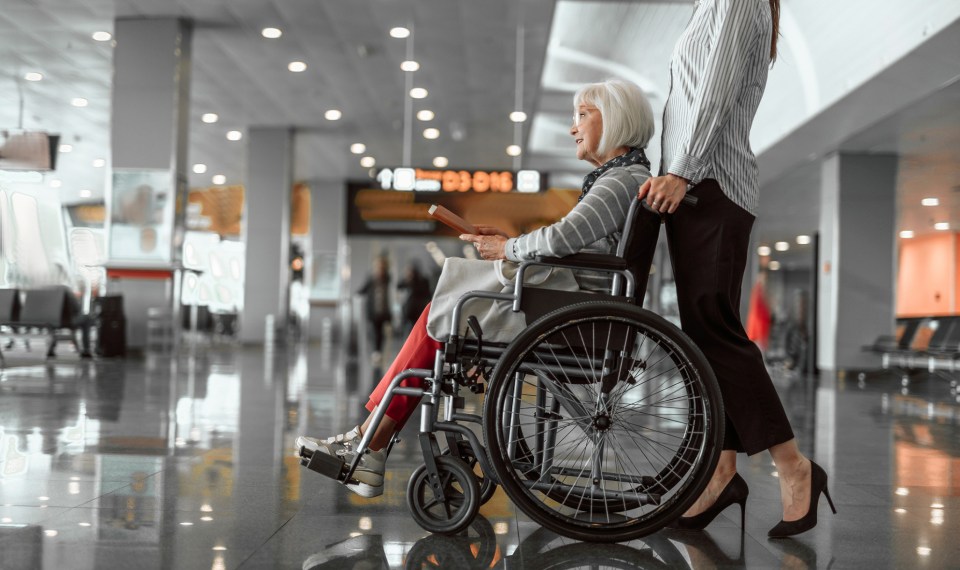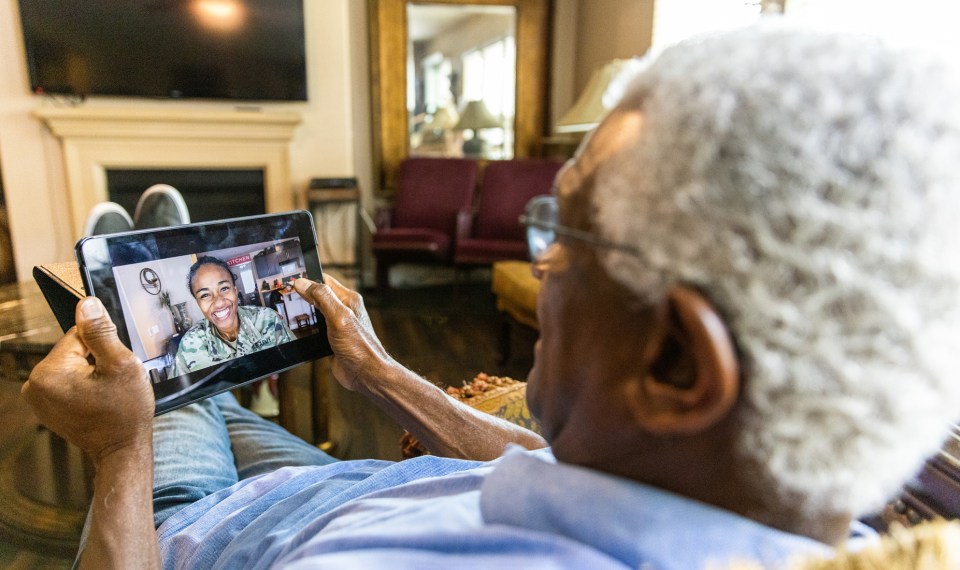Being a certain age or living with a disability doesn’t have to mean the end of travel or adventure. Today, there are more options than ever for traveling with limited mobility. With just a little advanced planning, you can visit the destination of your dreams.
Preparation is key to ensuring your trip goes smoothly. The best place to start is determining your mode of travel.
Summary
In this post you will find tips for:
Hitting the Road for Seniors and Those with Limited Mobility
Adaptive technologies are available that allow persons with disabilities to ride or drive safely and comfortably. Car manufacturers are stepping up to the challenge, and some new vehicles can be customized straight from the factory. Although the cost of a new vehicle with adaptive equipment can total $80,000 or more, certain modifications are much more affordable. Swivel cushions for seats start around $20 and pedal extensions range from $50-$200. Most major vehicle manufacturers offer rebates on adaptive equipment.
Below are just a few examples of adaptive equipment for vehicles:
- Hand controls – Multiple options including levers, buttons, knobs, and even remote controls can be installed allowing easier operation of brakes, acceleration, wipers, lights, steering and more.
- Seat modification – Drivers seats can be modified to assist in entering and exiting the vehicle. Swivel seats allow for easy entry and custom seats may also be lowered or even removed, depending on your need.
- Pedal adaptations – Extensions to raise the height of brake and accelerator pedals make it easier for drivers with short legs to reach the pedals while maintaining a comfortable distance from the steering wheel. Left foot gas pedals can also be installed.
- Vehicle lift – If you use a wheelchair, scooter or powerchair, a lift makes it possible to take your mobility device with you when you travel. Lift options include hitch mounts, which are mounted on the exterior of your vehicle; interior hybrid lifts for vans, minivans and SUVs that protect your mobility device from the weather; and truck lifts which transport your device in the bed of a pickup truck. There are many lift options that come in a wide range of price points.
- Accessories – Gear shift and turn signal extensions, swivel cushions, panoramic mirrors, and seatbelt helpers are just a few examples of the many mobility accessories that can enhance your driving experience.
Some inexpensive items you can easily order online are extremely helpful to anyone of limited mobility. A swivel seat cushion with a 360-degree rotation makes entering and exiting the vehicle much less challenging. Another easy-to-use addition that makes a big difference is the Handy Bar. Just pop the metal tip of the device into the U-shaped strike plate on the car door frame and use the sturdy grab handle for support getting into and out of the vehicle.
To ensure mobility equipment is installed correctly and safely, ask your dealer or search for a National Mobility Equipment Dealers Association (NMEDA) certified technician. The National Highway Traffic Safety Administration (NHTSA) has extensive information on selecting the right vehicle and adapting your vehicle, along with cost saving tips. Before purchasing any adaptive equipment for your vehicle, the NHTSA recommends you have an evaluation by a rehabilitation specialist to identify the equipment best suited to your needs and medical condition.
Bus Travel
Major bus lines such as Greyhound, Trailways and Jefferson offer accommodations for riders with mobility impairments. Services include:
- Assistance boarding and de-boarding the bus
- Priority seating at the front of the bus
- Accommodations for mobility devices
- Wheelchair and mobility device lifts
- Assistance de-boarding and re-boarding at rest stops
Most bus lines request advanced notice if you will be traveling with a mobility device. Keep in mind there may only be enough room on the bus for one or two wheelchairs, mobility scooters or powerchairs. Oxygen is generally allowed but check with the bus line when booking your trip.
If you have a disability and are traveling by bus, follow these tips:
- Book as far in advance as possible
- Arrive at least 35-40 minutes before departure
- During booking, signify if you are planning to sit in your mobility device while on the bus or transfer to a regular seat
- Add service requests to your reservation including any special needs you may have
- Stow all medications in a carry-on bag or keep them with you
- At boarding, communicate any special needs to the driver
- Check with the bus line if there are any weight limits; these vary but most are between 600-1000 pounds total
If you are traveling with oxygen, bring enough to last throughout the entire trip, including rest stops and transfers. Bring fully charged batteries. Trailways bus line recommends making sure your battery power has a minimum capacity of 150% longer than the duration of the trip.
Keep in mind that bus employees will not be available to remain with you throughout your journey. If you require continual care, it is your responsibility to bring a ticketed companion to assist you.
Train travel for the Physically Impaired
If you have always dreamed of hopping a train and traveling across the country, nowadays, it couldn’t be easier. With special accommodations and discounts, you can sit back and watch the world go by.
When riding the rails, disabled adults receive a 10% rail fare discount on Amtrak and, if you are traveling with a companion that will be assisting you during travel, they are also eligible for the 10% discount. Disabled children receive the standard 50% child discount plus the 10% disability discount. Downeaster trains—traveling between Boston and Portland, Maine—offer 50% off fares for adults with disabilities on that line.
When booking, go to the Fare Finder section and select either “Passenger with Disability” or “Companion” for the special rate. Be sure to book wheeled mobility device space, wheelchair transfer accessible seats and accessible bedrooms, if needed. Accessible rooms are available only for disabled persons traveling with a wheeled mobility device and must be reserved 14 days in advance of departure. You will be required to show proof of disability at the ticket counter and when boarding. The following will be accepted as proof of disability:
- Transit system ID card for disability
- Membership card from a disability organization
- Letter from your physician
- Medicare card, if you are over the age of 65
- Veterans ID card with “Service Connected”
- Disabled/Accessible parking placard issued by a state DMV (photocopies accepted)
If you are traveling on the Auto Train, you are only eligible for the disability discount if you are traveling with a wheeled mobility device.
Seniors, over the age of 65, also qualify for a 10% discount on most Amtrak trains but the discount does not apply to upgrades such as non-Acela business class, first class or sleeping accommodations. It also does not apply to flexible fares and cannot be combined with other discount offers.
Accessible Cruises
Cruises can be a wonderful way for the elderly or persons with a disability to travel. Some cruise lines provide transportation to the ship and help with boarding, handicap accessible rooms, wheelchair-friendly seating throughout the ship and even a chair lift to access the pool and hot tub. Since these services may not be available on all cruises, you should search for cruises that are geared to the disabled. Oxygen may be provided by the ship, or you may be able to bring your own. Confirm with the booking agent whether you need to bring your own.
As a rule, larger, newer ships are better equipped for passengers with disabilities. If mobility is a problem, it is best to avoid ships that use tenders (small boats used to shuttle passengers to and from the ship). The small boats can be difficult to navigate and may require passengers to use a folding manual wheelchair to board as motorized scooters and mobility devices cannot be accommodated on tenders. To avoid tenders, look for cruise ships that board directly from a pier.
It is important to note that even when you have successfully navigated the initial boarding process, the conditions at some ports of call may make it difficult to disembark or to navigate mobility devices. Uneven streets, steep inclines, and lack of accessible bathrooms can present a challenge. If you are unable to disembark, be aware policy typically states you will not be reimbursed for any missed ports.
Talk with your booking agent before purchasing a cruise and be open about your needs and limitations. Keep in mind, the number of accessible cabins is limited, so it is important to book well in advance.
Air Travel
Traveling by air is the fastest, and arguably one of the easiest ways for the elderly and those with disabilities to travel. While additional accommodations may be available, don’t expect these options to be provided on-the-spot. Requests for wheelchairs and carts should be made at the time of booking. Some tips for air travel include:
- Upon arrival let the airline know during check-in that you have requested a wheelchair or cart on your reservation and request at this time that a wheelchair be available at your destination
- Arrive early. Allow two to three hours for domestic flights and even more time if you are traveling internationally
- If you are bringing your own mobility device, plan on having motorized or electronic devices checked-in early and be ready to board at least 45 minutes before the flight. Non-motorized devices, such as a standard wheelchair, should be checked in and allow you to be ready to board at least 30 minutes before the flight
- If you are over 75, special screenings are available at security checks. Again, allow extra time if you are traveling with medical equipment and know it will be checked separately
- When purchasing tickets, select aisle seats near the front of the plane, when available
- If you require an onboard wheelchair for trips to the bathroom during the flight, this request must be made 48 hours in advance
- Service animals and emotional support animals are not treated the same. Many airlines do not allow emotional support animals. Be sure to have the proper documentation for your animal
- Airlines have different policies regarding disability travel. Check with your airline about their policies and procedures. Many allow mobility devices such as canes and wheelchairs and do not count these items toward your baggage or carry-on allowance
- Flying with oxygen requires a letter from your physician. Some airlines allow certain oxygen devices to be carried on while others require passengers use the onboard oxygen. Check early in advance to understand the airline’s policy
- If complications arise, ask to speak with the airlines Complaint Resolution Official (CRO) or supervisor. This person should be available in person or by phone for every flight and has the final say on issues
Ride Sharing Services
Once you reach your travel destination, finding wheelchair accessible transportation can be a challenge. In select major cities (New York, Boston, Chicago, London, Los Angeles, Washington, D.C., etc.) UberWAV can connect you with drivers who have accessible vehicles equipped with ramps or lifts.
Uber also offers the Uber Assist program available in 40 cities. This service utilizes drivers trained to assist seniors and disabled passengers with entering and exiting the vehicle and has trunk room to accommodate foldable wheelchairs, walkers and other assistive devices.
The Lyft app has an ‘Access Mode’ feature that allows passengers in certain markets to request wheelchair accessible transportation. If the service is not available in that area, the app will provide information on other local wheelchair accessible transportation services. Keep in mind that these referral services may require advanced notice.
Make a Plan, and Enjoy the Trip
Unfortunately, if you are a senior or have a disability, spontaneity is not an option. Travel does require advanced planning and preparation, but that doesn’t mean you should forego your trip. Book early and be clear as to what your needs are. A well-planned trip can be an exciting adventure and, as they say, getting there can be half the fun.
The content of this site is for informational purposes only and should not be taken as professional medical advice. Always seek the advice of your physician or other qualified healthcare provider with any questions you may have regarding any medical conditions or treatments.



